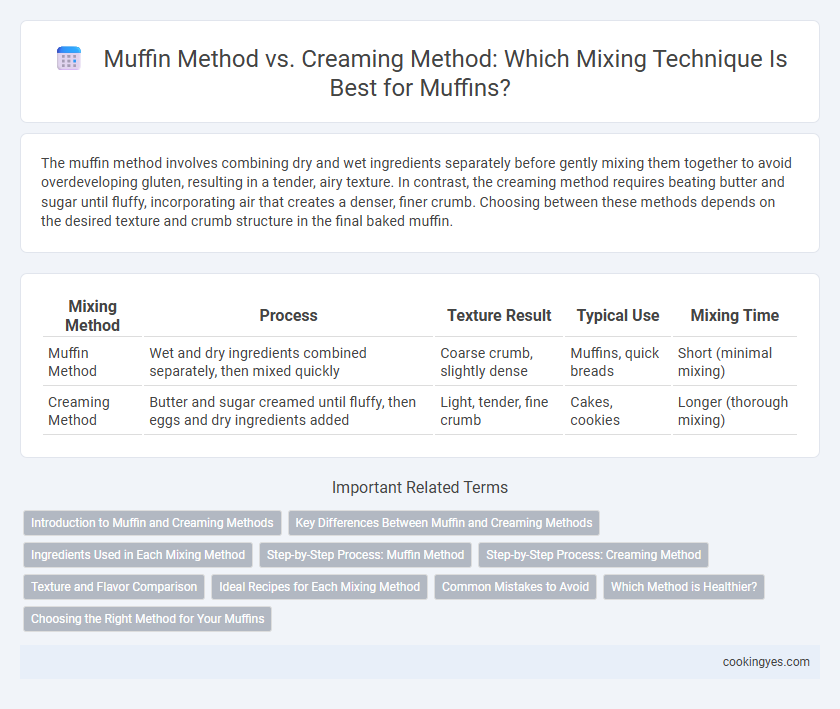The muffin method involves combining dry and wet ingredients separately before gently mixing them together to avoid overdeveloping gluten, resulting in a tender, airy texture. In contrast, the creaming method requires beating butter and sugar until fluffy, incorporating air that creates a denser, finer crumb. Choosing between these methods depends on the desired texture and crumb structure in the final baked muffin.
Table of Comparison
| Mixing Method | Process | Texture Result | Typical Use | Mixing Time |
|---|---|---|---|---|
| Muffin Method | Wet and dry ingredients combined separately, then mixed quickly | Coarse crumb, slightly dense | Muffins, quick breads | Short (minimal mixing) |
| Creaming Method | Butter and sugar creamed until fluffy, then eggs and dry ingredients added | Light, tender, fine crumb | Cakes, cookies | Longer (thorough mixing) |
Introduction to Muffin and Creaming Methods
The muffin method involves mixing dry and wet ingredients separately before combining them just until moistened, resulting in a tender, moist crumb ideal for quick breads and muffins. The creaming method requires beating butter and sugar together until light and fluffy, incorporating air that creates a finer, cake-like texture in baked goods. Understanding these distinct techniques helps bakers achieve desired textures and rise in muffins and cakes.
Key Differences Between Muffin and Creaming Methods
The muffin method involves mixing wet and dry ingredients separately before combining them gently to avoid gluten overdevelopment, resulting in a tender, coarse crumb. In contrast, the creaming method requires beating butter and sugar until light and fluffy before gradually incorporating eggs and dry ingredients, producing a finer, lighter texture with more volume. Key differences include mixing techniques, ingredient incorporation order, and the resulting crumb structure and density.
Ingredients Used in Each Mixing Method
The Muffin method uses a simple combination of wet and dry ingredients mixed separately, often including flour, sugar, baking powder, eggs, and milk, with minimal mixing to avoid gluten development. The Creaming method involves beating butter and sugar together until light and fluffy before gradually adding eggs and dry ingredients, resulting in a more aerated batter ideal for cakes. Ingredient ratios differ significantly between the two, as the Muffin method typically requires less fat and sugar compared to the Creaming method, which relies on butter's emulsifying properties for texture and flavor.
Step-by-Step Process: Muffin Method
The muffin method involves combining dry ingredients and wet ingredients separately before mixing them just until moistened, preventing gluten overdevelopment for a tender crumb. First, sift dry ingredients like flour, baking powder, and sugar in one bowl. Next, whisk wet ingredients such as eggs, milk, and melted butter in another bowl before gently folding the wet mixture into the dry until lumps remain.
Step-by-Step Process: Creaming Method
The creaming method begins by beating softened butter and sugar until light and fluffy, creating tiny air pockets that contribute to the batter's rise. Eggs are then added one at a time, thoroughly incorporating into the mixture to ensure even texture. Finally, dry ingredients and liquids are alternately folded in carefully, maintaining the aerated structure essential for a tender, crumbly muffin crumb.
Texture and Flavor Comparison
The muffin method creates a tender, coarse crumb with a denser texture by gently mixing wet and dry ingredients separately, which preserves air pockets for a moist, chewy bite. In contrast, the creaming method produces a lighter, fluffier texture by beating butter and sugar together, incorporating more air and resulting in a delicate crumb with enhanced sweetness. Flavor intensity tends to be richer in creaming due to the emulsification of fats and sugars, while the muffin method emphasizes a straightforward, buttery taste.
Ideal Recipes for Each Mixing Method
The muffin method, which involves gently combining wet and dry ingredients, is ideal for recipes like quick breads and muffins where a tender, tender crumb is desired without overmixing. The creaming method, requiring the beating of butter and sugar until light and fluffy, suits recipes such as classic pound cakes and butter cakes that benefit from a light, airy texture. Recipes with higher fat content and the need for incorporating air typically perform best with the creaming method, while those emphasizing simplicity and moisture retention align well with the muffin method.
Common Mistakes to Avoid
Overmixing batter is a common mistake in both the muffin and creaming methods, leading to dense and tough muffins due to gluten overdevelopment. In the muffin method, under-mixing can result in uneven texture with pockets of dry ingredients, while in the creaming method, failing to properly cream butter and sugar reduces batter volume and lightness. Avoiding these errors ensures a tender crumb and uniform rise in muffins regardless of the mixing technique used.
Which Method is Healthier?
The muffin method involves combining wet and dry ingredients separately before mixing, minimizing gluten development and resulting in a tender texture with less mixing, which can preserve nutrient integrity. The creaming method requires beating butter and sugar together, incorporating more air and often increasing fat content, potentially making it higher in calories and less health-conscious. Choosing the muffin method typically yields healthier baked goods due to lower fat usage and reduced overmixing that can affect nutrient quality.
Choosing the Right Method for Your Muffins
Choosing the right method for mixing muffin batter is crucial to achieving the perfect texture. The muffin method involves gently combining wet and dry ingredients to create a tender, moist crumb, ideal for fruit or nut-filled muffins without overmixing. In contrast, the creaming method incorporates butter and sugar until light and fluffy, producing a richer, finer crumb suitable for sweeter, cake-like muffins.
Muffin method vs creaming method for mixing batter Infographic

 cookingyes.com
cookingyes.com